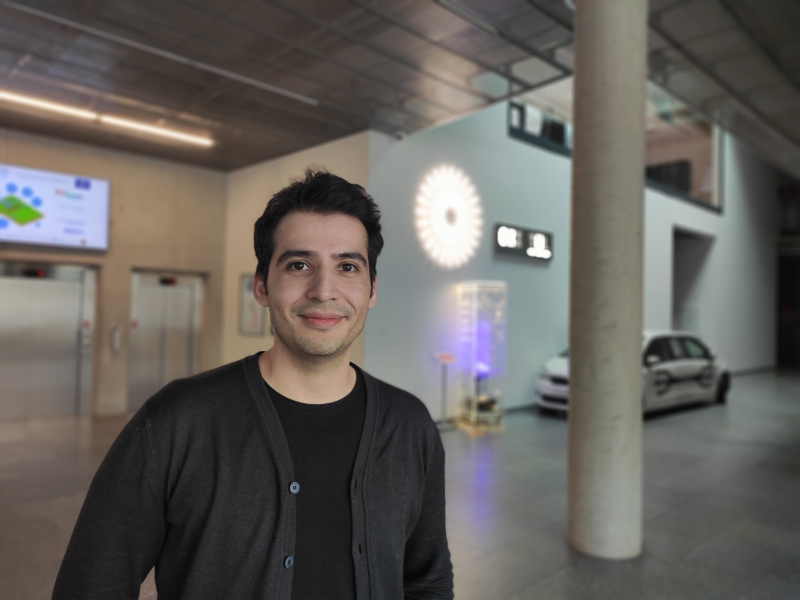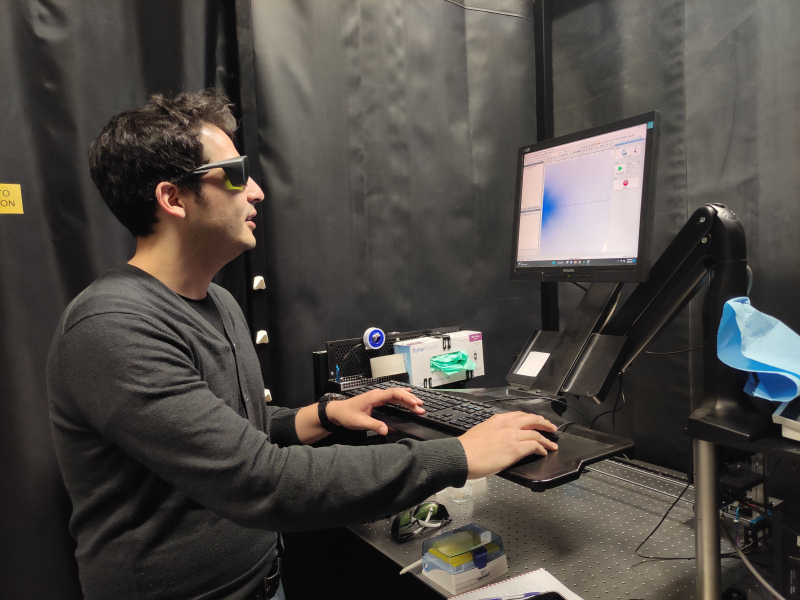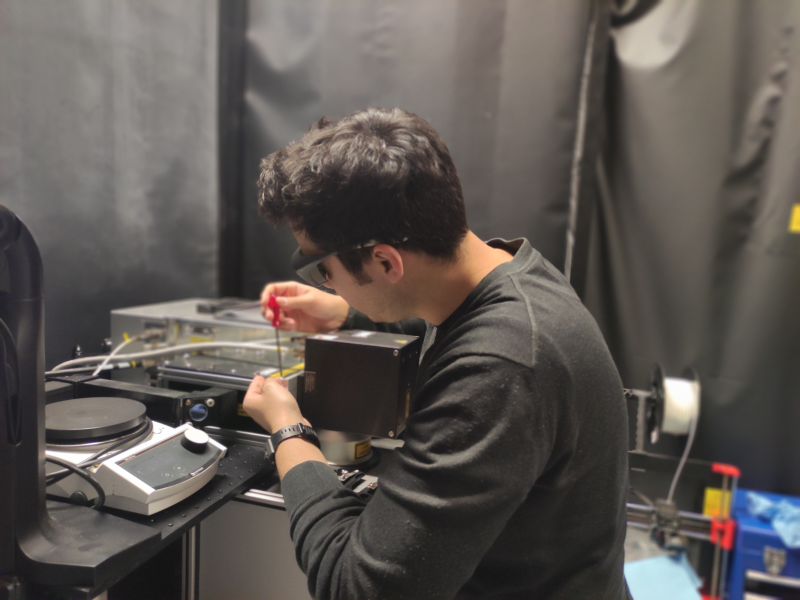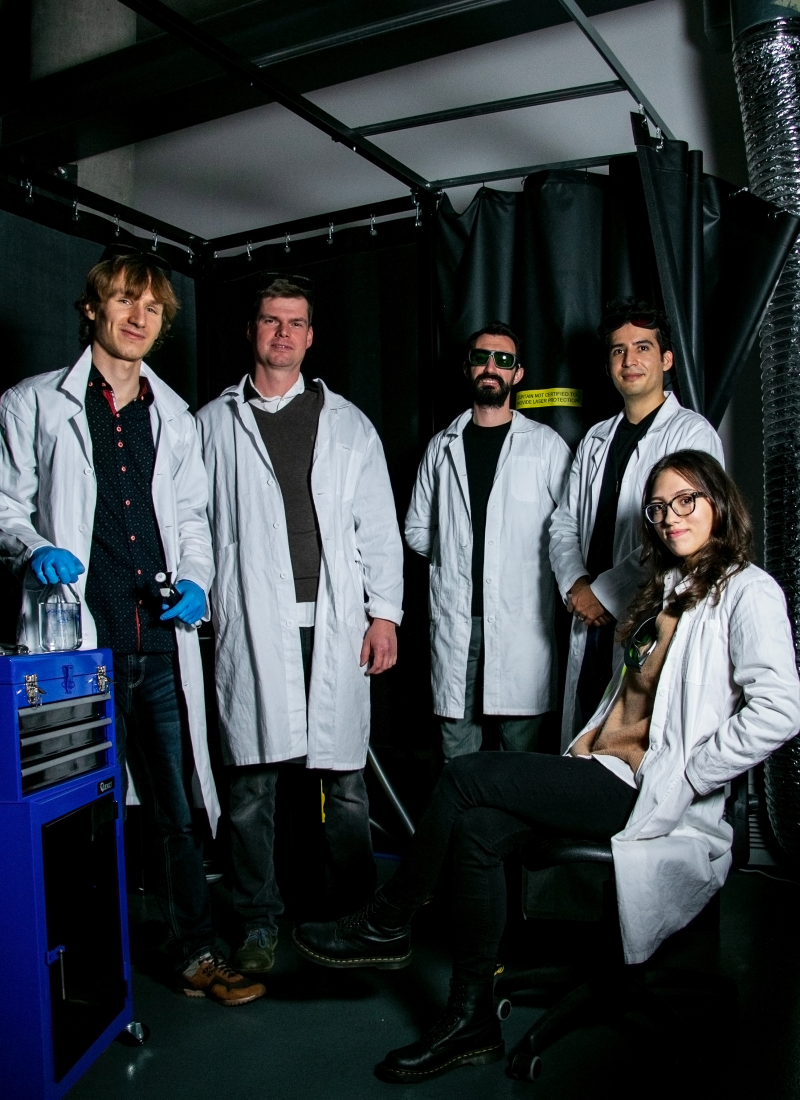Nanoworld formed by laser beams
9. 3. 2023
In his research, he creates new materials and combines many different elements. All with the help of pulsed lasers. Since 2017 he has been working at CXI in Liberec, where he founded, together with his talented students, the successful FEMTO-NANO group (2017). His professional vision is cutting-edge applications of nanomaterials, such as developing intelligent liquids or regenerating clean water from polluted sources. In addition to his research, he educates students, has won several prestigious awards, and was a European start-up competition winner. About all these, we talked to Rafael Omar Torres Mendieta.

When did you first encounter research? Since when have you been working in science, and since when at CXI?
My professional career started more than ten years ago in Mexico with the study of non-linear optical properties in nanostructured materials (second-order and third-order nonlinearities) through the employment of ultrafast laser sources. In the course of time, after witnessing atypical properties arising from the interaction between ultrafast light and matter structured at the nanoscale, it was inevitable to expand my research perspectives to laser-based matter manipulation. Thus, I moved to Spain to pursue such an ambition, where I was given the opportunity to help establish a new research line in the optics research group (GROC) with my Ph.D. thesis. The group led by Prof. Jesús Lancis Sáez, current vice-rector for research and transfer at the University Jaume I, has been considered among the best photonics research teams within the Spanish territory for years. However, after their long-awaited incorporation in the consortium Science and Applications of Ultrafast Ultraintense Lasers (funded by the European Consolider Programme), it became crucial to explore cutting-edge applications derived from the employment of ultrafast lasers, a perfect match for my career vision. During the development of my Ph.D. thesis, I realized the incredible reach of manipulating matter by ultrafast laser sources. Such a research line allowed me to be part of various projects that got me in contact with top researchers worldwide, like Prof. Honoris Causa, Elson Longo, considered one of the best scientists in Brazil, Prof. Alexander Pyatenko, who is one of the pioneers in the laser modification of nanomaterials, or Prof. Ing. Anton Fojtík, CSc., the co-inventor of one of the most powerful techniques for the creation of ultra-pure nanomaterials by lasers; Laser Ablation in Liquids. After completing my Ph.D. studies, I became a postdoctoral researcher at the University Jaume I, Spain, where I started to gain international recognition in my research field, but as it is necessary when devoting oneself to a scientific career, it was the moment to leave my alma mater with the objective to build my own research path.
Since when have you been working in science and since when at CXI?
After looking for various opportunities, it was clear that the Institute for Nanomaterials, Advanced Technologies and Innovation (CXI) was the perfect fit for me. Although the Institute did not have a long history at that time, it was attracting very talented researchers with exciting ideas, it was getting well-equipped for doing cutting-edge research, and above all, it was open to new promising research lines. This is how I came to CXI, and since 2017 I have established a young and highly motivated research team, today known as the FEMTO-NANO group, formed by the very talented rising stars Ing. Ondřej Havelka, Ing. Sabrin Abdallah, Ing. Belin Bilgin Sabit, and Bc. Jan Braun, with whom I have had the honor to work together to develop a new and very fruitful research line.
What are you involved in your research?
For my research line, I produce new materials employing pulsed lasers. A fascinating aspect about these types of lasers is that unlike the typical continuum wave lasers (from pointer lasers to industrial lasers used for cutting or engraving), the pulsed ones concentrate much energy in very short pulses. The pulses can be so short that extremely fast events, for instance, the movement of electrons inside atoms, can be seen. This is, however, not the only thing we can do with these lasers; their extremely short duration also means the concentration of energy in the pulse is massive, as much as when interacting with any type of matter, including air, liquids, or solids, it is possible to transform it profoundly. Such deep transformations include rearranging atoms or even unifying elements that do not naturally come together.

What applications does your research enable?
Because these new materials also have new physicochemical properties, they can be employed in various applications like biological labeling, intelligent fluids development, reclamation of pure water from oily polluted sources, and, as we very recently demonstrated, killing bacteria very efficiently. This latest work is particularly interesting because the combination of the well-known antibacterial silver element with iron permitted the creation of a new generation of antibacterial material with the capacity to move by magnets. The opportunity to drive an antibacterial material without touching it is very appealing because you could kill bacteria in difficult-to-access locations, like the small holes in medical instruments that tend to host opportunistic bacteria, which are the main cause of complications during surgical interventions, or even direct them inside the human body to specific locations where, for instance, a threatening bacterial population locates.
What projects are you currently involved in?
Currently, I am involved in three main projects dealing with nanomaterials applications. The first one is an SGS project aiming to produce new nanocatalysts, where my primary role is advising and supervising the students developing the project. The second one is centered on developing nanomaterials for environmental protection and a sustainable future, where my primary role is to find nanomaterial-based solutions for current environmental problems, such as water pollution, one of the largest crises our society is facing.
Finally, the third one is about sustainable remediation of radionuclide impacts on land and critical materials recovery, where my role is more focused on the critical materials recovery part. Considering the lasers I am employing can generate extreme conditions in various mediums, it is possible to extract elements such as raw critical minerals from many types of environments, which ultimately could help us combat the current shortage worsened by a combination of the political climate we are living, the post-pandemic crisis, and the current unexpected weather disasters.
You are part of the Department of Enviromental Chemistry team. With whom do you collaborate?
Even though I work synergistically with my colleagues at the OECH department, I also collaborate strongly with many research teams in the CXI, the TUL faculties, and abroad.
As once stated by the Nobel prize recipient of 1982, Kenneth G. Wilson: "The hardest problems of pure and applied science can only be solved by the open collaboration of the worldwide scientific community"
And just as this brilliant mind mentioned, I have been able to witness in person how the greatest challenges of my scientific career have been solved through cooperation. This, in particular, has led me to develop extraordinary materials that have obtained great international recognition, such as the one that a semiconductor material we created got from the nature editorial group. This is a material that arose from a collaboration between our group at CXI, the Federal University de Sao Carlos in Brazil, and the University Jaume I in Spain.
How is your research typical and/or different from other assignments/projects in your department?
Although the members of our department come from different backgrounds, we all have found a way to combine our skills to generate new knowledge. For instance, the chemistry background of my colleague Stanislaw Waclawec and my former colleague Vinod Padil have perfectly complemented my physics background, allowing us to explore new applications for our materials, such as acceleration of chemical reactions necessary for degrading organic pollutants found in water, or understanding why immiscible elements like Fe and Cu could be forced to get together forming nanomaterials not explored before.

What other institutions or industrial partners do you collaborate with?
My key collaborators come from the Feredarl University of Sao Carlos (Brazil), the University Jaume I (Spain), the University of Padova (Italy), the Silesian University of Technology (Poland), the Wrocław University of Science and Technology (Poland), the Tomas Bata University in Zlín (Czech Republic), and the Institute of Microbiology of the Czech Academy of Sciences (Czech Republic).
Can you tell us any interesting facts from your research?
I would say the most exciting fact about this research line is that it allows you to generate new materials, combining elements that do not come along naturally. Moroever, you can control where every element should be located in your new material, allowing you to get extraordinary properties. This is the case of a silver tungstate semiconductor, which interaction with the laser radiation permitted a redistribution of its atoms allowing it to get massive antibacterial properties (https://doi.org/10.1038/s41598-018-19270-9). Another extraordinary material is a membrane whose union with precisely engineered AgTi nanoalloys enabled the simultaneous recovery of water from oily polluted sources while degrading organic pollutants that usually accompany the oils (https://doi.org/10.1016/j.apsusc.2021.150471). Or the generation of AgFe nanodevices whose ability to respond to magnetic stimuli permitted the suppression of bacterial growth in difficult-to-access locations (https://doi.org/10.1039/D2NR03902H).
Finally, I would like to share that the scientific curiosity to deepen the knowledge in these topics has also inspired various students from my research group (FEMTO-NANO group), of whom I have had the honor of supervising their bachelor's, master's, and Ph.D. theses, which have been recognized by a number of respected national institutions in the Czech Republic; such as the Ministry of Education, Youth and Sports of the Czech Republic; the Technical University of Liberec through the Rector's and Dean's award for best thesis; and regional bodies in the form of academic distinctions (CRYTUR Awards). Additionally, this research line led me to obtain first place in the 2021 edition of the EIT Jumpstarter competition (Raw materials category); by the European Institute of Innovation and Technology (EIT), recognizing the most promising ideas for technology transfer and entrepreneurship. This experince led me into direct contact with potential industrial partners demanding laser-manufactured ultra-pure or morphologically atypical nanomaterials and improved my view of the nanotechnology industrial ecosystem in Europe and the current trends in the materials processing sector.

What are your next plans?
Given the positive and promising experinece I had with the technology transfer sphere, I realized that my team should establish and develop as a strategic partner for industries towards joint R&D projects. In addition, we must expand our cooperation network to reach leading international actors in science and technology. This will be achieved by pursuing increasingly ambitious scientific and technological objectives, contributing to accelerating the scientific excellence and international recognition of our institution.




.png)
.jpeg)
.png)
.jpeg)
.png)
.jpeg)
.png)


.png)